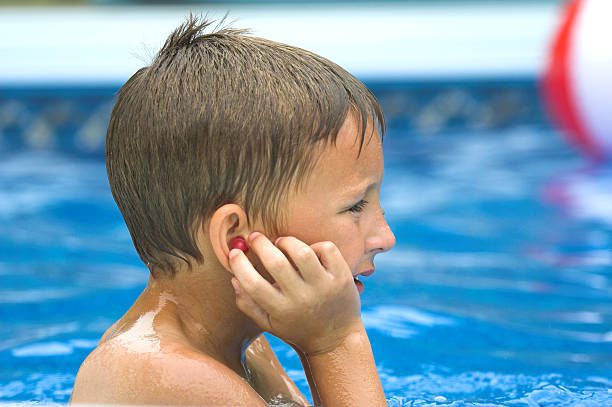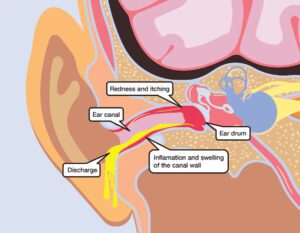Preventing Swimmer’s Ear for a Fun-Filled Summer

Key Points:
- Swimmer’s ear, or acute otitis externa, is not contagious and can’t be spread from person to person.
- Swimmer’s ear risks include swimming in dirty water, having cuts or injuries in the ear canal, using objects like cotton swabs, and having skin conditions like eczema.
- Mild swimmer’s ear can sometimes heal on its own, but severe cases need treatment.
As temperatures rise, parents and kids often seek enjoyable outdoor summer activities such as swimming at pools or beaches. However, sometimes, a fun day at the beach can result in an uncomfortable ear infection known as swimmer’s ear.
What Is a Swimmer’s Ear?
Swimmer’s ear, or acute otitis externa, is a bacterial infection that happens when water stays in your outer ear canal for too long. This breaks down the ear’s protective wax and skin, creating a moist environment where bacteria can grow.
About 10% of people will experience swimmer’s ear at some point in their lives. Research shows that getting the right treatment and managing it well can effectively prevent possible complications. While anyone can get swimmer’s ear, it’s most common in children. It’s important to know that a swimmer’s ear is not contagious and cannot be spread from one person to another.
Signs and Symptoms of Swimmer’s Ear
According to the CDC, doctors often categorize swimmer’s ear into mild, moderate, and advanced stages depending on how severe it becomes over time. Common symptoms are:
- Pain when you pull on your outer ear or press on the little bump in front of your ear canal (tragus)
- Itchiness inside the ear
- Fluid draining from the ear
- Redness and swelling in the ear

Who is at Risk for a Swimmer’s Ear?
- Come into contact with germs in dirty hot tubs or pools
- Have a cut in your ear canal skin
- Injure your ear canal by inserting objects like cotton swabs or fingers
- Use headphones, hearing aids, or swim caps frequently
- Have a skin condition like eczema
How to Prevent Swimmer’s Ear
Keep Your Ears Dry and Clean
After swimming or bathing, make sure to dry your ear canals thoroughly. Tilt your head to each side to let the water drain out completely. You can also gently use a hair dryer on the coolest setting if needed to dry the ear canal.
Avoid Swimming in Dirty Water
Swimmer’s ear can happen if you swim in water that isn’t properly treated or has high levels of bacteria. This includes natural bodies of water, as well as public or private pools that aren’t well maintained.
You can also check the pH and disinfectant levels on your own by using pool test strips.
Maintain Proper Ear Wax Hygiene
Ear wax, also known as cerumen, helps prevent ear infections and keeps water out of your ears. You can usually clean away extra ear wax with soap and water in the shower or with a damp cloth.
Avoid putting Q-tips or other objects in your ears as they can push wax deeper or harm your ear canal. Steer clear of ear candling and other improper cleaning methods that can damage your ears and increase infection risk.
If you have a lot of ear wax, see a healthcare provider for professional cleaning. After ear irrigation, avoid swimming or using a hot tub for a few weeks to allow any minor skin abrasions to heal properly.
Use Earplugs When Swimming
Wearing earplugs when swimming or bathing can help prevent swimmer’s ear by keeping water out of your ears.
You can buy soft, moldable earplugs at healthcare providers’ offices or many stores. Make sure to choose earplugs that fit well and are designed specifically to keep water out, not the foam kind used for noise reduction or ear pressure.
Avoid Inserting Foreign Objects In Your Ear
Avoid using items like cotton swabs, paper clips, or hairpins to scratch an itch or remove earwax. These can push material deeper into your ear canal and irritate or damage the delicate skin inside your ear.
How is a Swimmer’s Ear Diagnosed?
To diagnose a swimmer’s ear, your doctor will first ask about your medical history and current symptoms. They will then conduct a physical exam, which includes looking into both of your ears using a lighted tool called an otoscope. This helps them check for any signs of infection in your outer and middle ear.
If there is pus draining from your ear, your provider may take a sample of it for testing. This involves gently placing a cotton swab into your ear canal to collect the sample, which is then sent to a lab to determine the cause of the infection.
Does a Swimmer’s Ear Go Away on Its Own?
Mild cases of swimmer’s ear can sometimes get better on their own within a few weeks. However, if your symptoms are more severe, it may take longer to heal. With proper treatment, swimmer’s ear typically clears up in 7-10 days.
Should I Go to the Doctor for Swimmer’s Ear?
Even if your symptoms of swimmer’s ear are mild, it’s important to see your primary care doctor. They can determine the cause of your symptoms and start you on the right treatment.
Seek immediate medical attention if you have:
- Fever
- Severe pain in or around the ear
- Changes in hearing
- Discharge from your ear that is yellow, yellow-green, or has a foul smell
Your doctor will examine your ear and may ask you some questions to diagnose the swimmer’s ear. If there is pus draining from your ear, they may collect a sample for testing.
Visit any of our DOC-AID Urgent Care Clinic location if you have persistent ear pain or concerns after 2-3 days of self-care. We have clinics in Laredo Tx, Weslaco Tx, and Pharr Tx, all open seven days a week with extended hours. Book an appointment online or walk-in today!



